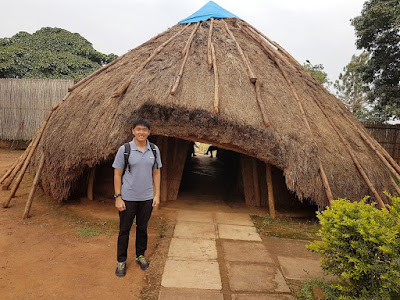---
JPN: Shuri Castle <YOU ARE HERE!>
To go to the castle, my BFFs and I took the monorail to Shuri station, which used to be one of the terminus, but it's no longer the case now.
 |
| The monorail in Naha is called Yui Rail. |
 |
| If you're going to ride on the monorail a lot of times, you should consider the 1-day or 2-day ticket. |
Depending on your walking speed, it probably takes at least 10 minutes to walk from the station to the castle.
 |
| The Gusuku Sites and Related Properties of the Kingdom of Ryukyu consists of nine sites, a fine representation of the kingdom's culture that represents a unique Japanese-Chinese blend. |
The original castle was actually almost completely destroyed during the Battle of Okinawa in 1945. It was one of the bloodiest wars in the Pacific, where many innocent Okinawans were killed in the 3-month battle between the American and Japan military forces.
 |
| Be prepared to climb a few flights of stairs, but they aren't steep. |
 |
| The castle is situated atop a small hill that's about 120 to 130 m in altitude. |
Back in 2015, the admission fee was ¥820 (~S$10.15) per adult. At the point of writing, as there are less things to see, it costs ¥400 (~S$4.95) per adult to enter the compounds.
The actual date of construction of Shuri Castle remains unknown till date, but it was clearly in use as a castle during the Sanzan period from 1322 to 1429.
 |
| Unlike Japanese castles, Shuri Castle was greatly influenced by Chinese architecture with red as the dominant colour. |
 |
| All of the buildings are modern reconstructions as they've been destroyed a few times till now. |
 |
| It was King Sho Hashi who unified the three principalities of Okinawa and established the Ryukyu Kingdom in 1429. |
The castle operated as not only a base of political and military control in the past, but also a central religious sanctuary for the Ryukyuan people.
I believe that's the menu served during the 26th G8 summit held in Okinawa from 21 to 23 July 2020.
Take a look at the faucets inside the toilet that I went to.
Upon seeing a vending machine dispensing local Fanta flavoured with shiiquasa, a kind of citrus fruit akin to lime that's native to Okinawa and Taiwan, I immediately got one bottle for myself. I can't remember much of the taste now, but it was refreshing enough for sure.
Don't forget to get some gifts or grab a bite.







































Comments
Post a Comment